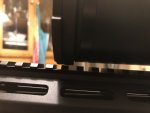You probably don't need to. The 1.5" height would only be necessary if your scope had a big erector housing that extended downward from the tube so far that it hit the bridge between the shorter mount's two rings, or if your rifle had a full-length rail that extended forward all the way past the scope objective, as it does in some tactical chassis setups.
Here's a photo from the Manners website. It shows separate rings rather than a one-piece mount, but you can imagine that if there were a thick bridge between the rings, the erector housing would just barely clear that bridge. So this scope fits on this rail, but you can see that if the bottom of the erector housing were much bigger, or if the rail extended all the way forward, the scope wouldn't fit without a taller mount:
View attachment 6967175
What
@mrtoyz is suggesting, I think, is that you
can -- but you don't have to -- use a taller mount with an aftermarket stock, so long as that stock has an adjustable comb that can be raised to position your eye at any scope height (like the Manners stock pictured above). The factory CTR stock doesn't have a height-adjustable comb, though, so if you were going to use the factory stock you'd want to keep the scope as low as possible.
The way you're thinking about angled mounts is completely understandable. You're right; you'll never need to dial much, if any, down elevation. But three things:
- The amount of up adjustment that you need is directly related to the distance you're shooting, and a 6.5 Creedmoor doesn't shoot far enough to need an enormous amount.
- To zero your scope at 100 yards, you'll need to dial out (by dialing down) most of the up- elevation that's built into your angled mount. So if your mount is too steep, the down adjustment provided by your scope might not be enough.
- Scopes generally perform best when the erector isn't dialed all the way to the up or down extremes, so it's best if you can arrange things so you're usually near the middle of the range. Therefore, you don't want to use a really steep mount to take ALL of the down adjustment out, even if you CAN barely get your scope zeroed with it.
So instead of using the mount to take 40 MOA out of the 50 MOA down adjustment that your scope provides, use a mount that will only take 20-30 MOA out. After zeroing, your erector will always be at least 20-30-or-so MOA off the bottom, and you'll still have plenty (70-80+ MOA) of up adjustment that you can use to dial for distance.


